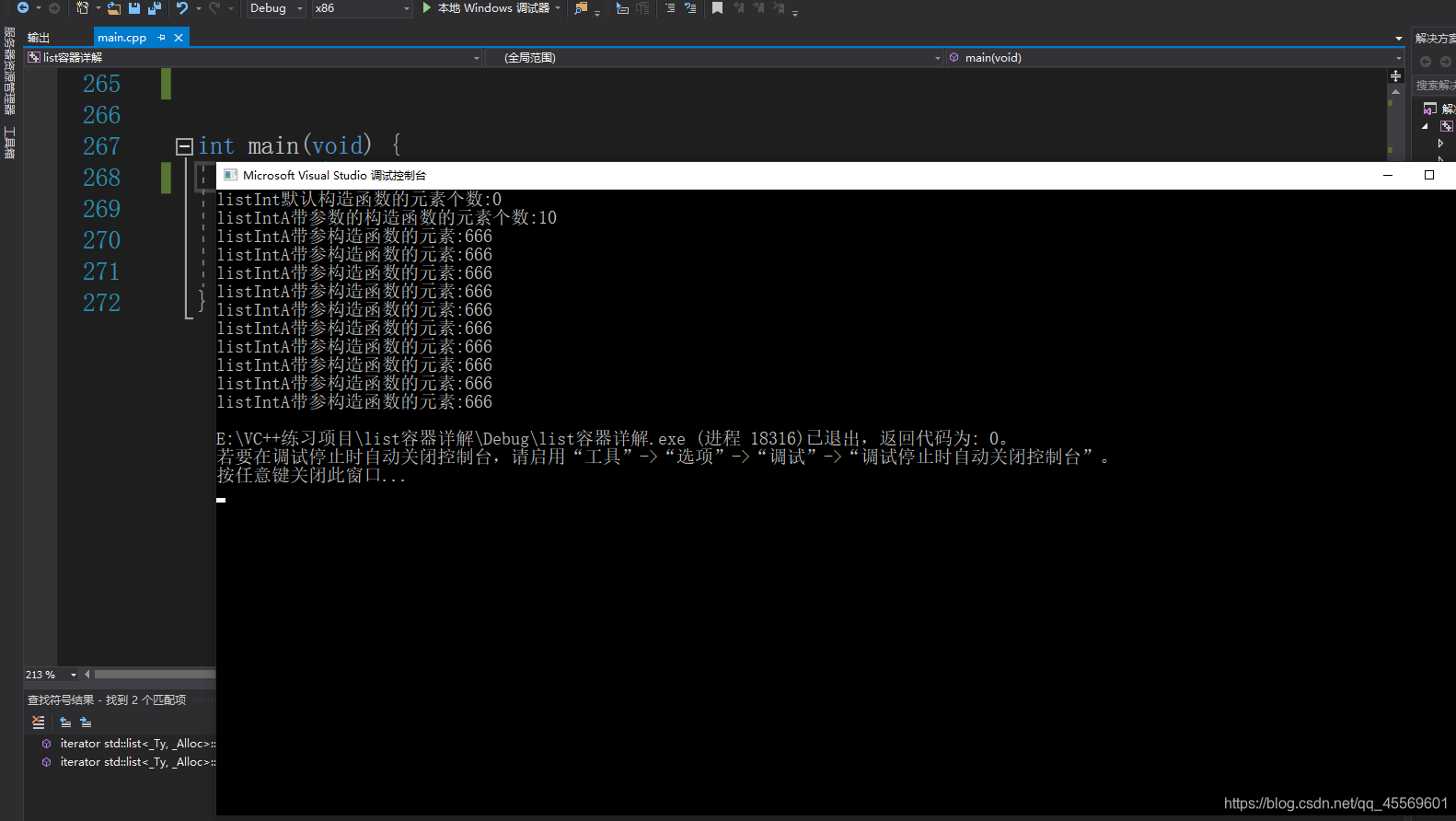c++STL中的List容器详解
2020-03-05 17:30
204 查看
c++STL中的List容器详解
一、提要
List 是一个双向链表容器,List容器能够在任何地方快速的删除添加元素。
List 容器的接口与其他容器的接口相似,List容器不能随机数据存取元素(如:用下标或者用at.()方法都是不可以的),数据存取我有必要提一下,因为我以前也搞不懂,我今天问了老师才知道,数据存就是把数据存进去,修改它的值,取就是把数据取出来,这里存的什么值,使用迭代器时可以进行++操作,但不可以进行+3,+4操作,使用时需包含头文件 和deque 容器相同的操作时我只是复习一下的知识,就简单的提一下,不会去深讲,有需要的可以去看我之前发的deque容器详解
二、List 容器的构造函数
//List 容器默认构造函数和带参数的构造函数
void demo1(void) {
//List默认构造函数
list<int> listInt;
cout<<"listInt默认构造函数的元素个数:" << listInt.size() << endl;
//List带参数的构造函数
list<int> listIntA(10,666);
cout << "listIntA带参数的构造函数的元素个数:" << listIntA.size() << endl;
vector<int> vectInt;
vectInt.capacity();
//List 容器没有capacity() 容量函数 不存在预先分配空间
//List 使用迭代器访问元素
for (list<int>::iterator it = listIntA.begin(); it != listIntA.end(); it++) {
cout <<"listIntA带参构造函数的元素:"<< (*it) << endl;
}
}
运行结果:

三、List 容器的头尾添加删除操作和数据的存取
//List 容器的头尾添加删除操作和数据的存取
void demo2(void) {
list<int> listInt;
//在尾部追加元素
listInt.push_back(1);
listInt.push_back(2);
listInt.push_back(3);
listInt.push_back(4);
listInt.push_back(5);
//在头部删除元素
listInt.pop_front();
listInt.pop_front();
//在尾部删除元素
listInt.pop_back();
listInt.pop_back();
//头部添加元素
listInt.push_front(11);
listInt.push_front(12);
//使用迭代器遍历打印
for (list<int>::iterator it = listInt.begin(); it != listInt.end(); it++) {
cout << "listInt添加删除过后:" << (*it) << endl;
}
cout << "------------数据存取------------" << endl;
//数据的存取
listInt.back() = 14;//listInt的最后一个元素赋值为14
listInt.front() = 16;//listInt的前面第一个元素赋值为16
for (list<int>::iterator it = listInt.begin(); it != listInt.end(); it++) {
cout << "listInt数据存取过后:" << (*it) << endl;
}
}
运行结果:

四、List 容器与迭代器
//List 容器与迭代器
void demo3(void) {
list<int> listInt;
//这里与deque相似可以看我以前发的deque容器详解,这里只是回顾一下以前的知识.
listInt.push_back(1);
listInt.push_back(2);
listInt.push_back(3);
listInt.push_back(4);
listInt.push_back(5);
//使用普通的迭代器遍历打印
for (list<int>::iterator it = listInt.begin(); it != listInt.end(); it++) {
cout << "listInt的元素:" << (*it) << endl;
}
cout << " -----------------常量迭代器---------------------" << endl;
//使用常量迭代器遍历打印
for (list<int>::const_iterator cit = listInt.cbegin();cit != listInt.cend(); cit++) {
cout << "listInt的元素:" << (*cit) << endl;
}
cout << " -----------------逆转迭代器---------------------" << endl;
//使用逆转迭代器遍历打印
for (list<int>::reverse_iterator rit = listInt.rbegin(); rit != listInt.rend(); rit++) {
cout << "listInt的元素:" << (*rit) << endl;
}
}
运行结果:

五、List 容器的赋值和大小
//List 容器的赋值和大小
void demo4(void) {
list<int> listInt,listIntA,listIntB,listIntC;
listInt.push_back(1);
listInt.push_back(2);
listInt.push_back(3);
listInt.push_back(4);
listInt.push_back(5);
//第一种
//指定区间,listInt.begin()到listInt.end()的元素,赋值给listIntB
//注意:包括listInt.begin()但不包括listInt.end()指向的元素(左闭右开),
listIntB.assign(listInt.begin(), listInt.end());
for (list<int>::iterator it = listIntB.begin(); it != listIntB.end(); it++) {
//打印结果:1,2,3,4,5 listIntB.end() 不是指向的5,是指向的5后面的元素
cout << "listIntB的元素:" << (*it) << endl;
}
//也可以用前置++ 前置--
listIntB.assign(++listInt.begin(), --listInt.end());
for (list<int>::iterator it = listIntB.begin(); it != listIntB.end(); it++) {
//打印结果: 2,3,4
cout << "listIntB使用前置--++赋值的元素:" << (*it) << endl;
}
//第二种,
//指定元素个数和元素值
listIntC.assign(4,666);
for (list<int>::iterator it = listIntC.begin(); it != listIntC.end(); it++) {
//打印结果: 666,666,666,666,
cout << "listIntC使用是指定元素个数和元素值赋值:" << (*it) << endl;
}
//第三种 使用赋值构造函数
listIntA = listIntC;
for (list<int>::iterator it = listIntA.begin(); it != listIntA.end(); it++) {
//打印结果: 666,666,666,666,
cout << "listIntA使用赋值构造函数构造listIntC的元素:" << (*it) << endl;
}
cout << "---------------list容器的大小--------------" << endl;
//这里与deque相似可以看我以前发的deque容器详解,这里只是回顾一下以前的知识.
list<int> listIntD;
listIntD.push_back(1);
listIntD.push_back(2);
listIntD.push_back(3);
if (!listIntD.empty()) {//empty
int size = listIntD.size();//size=3
listIntD.resize(2); //resize函数是重新定义元素个数//1,2
listIntD.resize(5);//1,2,0,0,0
listIntD.resize(7, 22);//1,2,0,0,0,22,22
}
for (list<int>::iterator it = listIntD.begin(); it != listIntD.end(); it++) {
//打印结果://1,2,0,0,0,22,22
cout << "listIntD的元素:" << (*it) << endl;
}
}
运行结果:

六、list 容器的插入和删除,还有反序排列
//list 容器的插入和删除,还有反序排列
void demo5(void) {
list<int> listInt;
list<int> listIntA(4, 333);
listInt.push_back(1);
listInt.push_back(2);
listInt.push_back(3);
listInt.push_back(4);
listInt.push_back(5);
cout << "-----------------------元素的插入----------------" << endl;
//这里与deque相似可以看我以前发的deque容器详解,这里只是回顾一下以前的知识.
//list容器的插入
//第一个参数常常是需要插入的迭代器位置
cout << " 第一种 " << endl;
//第一种: 指定区间插入 注意:左闭右开
listInt.insert(listInt.begin(), listIntA.begin(), listIntA.end());
for (list<int>::iterator it = listInt.begin(); it != listInt.end(); it++) {
cout << "listInt的元素:" << (*it) << endl;
}
cout << " 第二种 " << endl;
//第二种:指定元素个数和元素值 在2的位置插入2个666
listInt.insert(++listInt.begin(),2,666);
for (list<int>::iterator it = listInt.begin(); it != listInt.end(); it++) {
cout << "listInt的元素:" << (*it) << endl;
}
cout << " 第三种 " << endl;
//第三种:指定元素值 在最后的位置插入一个6
listInt.insert(listInt.end(), 6);
for (list<int>::iterator it = listInt.begin(); it != listInt.end(); it++) {
cout << "listInt的元素:" << (*it) << endl;
}
cout << "--------------元素的删除------------------" << endl;
list<int> listIntB;
listIntB.push_back(1);
listIntB.push_back(2);
listIntB.push_back(3);
listIntB.push_back(4);
listIntB.push_back(5);
listIntB.push_back(6);
listIntB.push_back(7);
cout << " 第一种 " << endl;
//这里与deque容器有些不一样
//list容器 迭代器只能++或--不能执行+3,+4操作
list<int>::iterator begin = listIntB.begin();
list<int>::iterator end = listIntB.end();
--end;
--end;
++begin;
++begin;
//第一种: 指定区间删除 注意:左闭右开
//begin迭代器指向容器的第三个元素end指向容器的倒数第二个元素
//begin到end的元素删除 注意:左闭右开
listIntB.erase(begin,end);//erase()函数返回值是下一个位置的迭代器
for (list<int>::iterator it = listIntB.begin(); it != listIntB.end(); it++) {
//打印结果: 1,2 ,6,7,
cout << "listIntB的元素:" << (*it) << endl;
}
cout << " 第二种" << endl;
//第二种: 指定位置删除
//把容器的第一元素删除
listIntB.erase(listIntB.begin());
for (list<int>::iterator it = listIntB.begin(); it != listIntB.end(); it++) {
//打印结果: 2 ,6,7,
cout << "listIntB的元素:" << (*it) << endl;
}
cout << " 第三种 " << endl;
listIntB.push_back(4);
listIntB.push_back(4);
listIntB.push_back(4);
listIntB.push_back(4);
//第三种:删除指定元素
//会把元素值相同的全部删掉
listIntB.remove(4);//rmemove()方法
for (list<int>::iterator it = listIntB.begin(); it != listIntB.end(); it++) {
//打印结果:还是 2 ,6,7,
cout << "listIntB的元素:" << (*it) << endl;
}
cout << " 第四种 " << endl;
//第四种:迭代器遍历删除
//迭代器遍历删除6这个元素
for (list<int>::iterator it = listIntB.begin(); it != listIntB.end();) {
if (*it == 6) {
//erase()函数返回值是下一个位置的迭代器,这时it已经指向了一个位置;
it = listIntB.erase(it);
}
else {
cout << "listIntB的元素:" << (*it) << endl;
//erase()函数返回值是下一个位置的迭代器只有不经过上面的if()
it++;//it++如果放在上面不行,越界了
}
}
cout << "--------------反序排列---------------" << endl;
listIntB.push_back(1);
listIntB.push_back(2);
listIntB.push_back(3);
listIntB.push_back(4);
//reverse() 函数可以逆转链表如1,2,3,4,5,用reverse()函数之后就是5,4,3,2,1,
listIntB.reverse();
for (list<int>::iterator it = listIntB.begin(); it != listIntB.end(); it++) {
cout << "listIntB的元素:" << (*it) << endl;
}
}
运行结果:

七、结尾
deque容器没有的还有忘写了的,全都在这代码的注释里了。
- 点赞
- 收藏
- 分享
- 文章举报
 ~永远永远~
发布了8 篇原创文章 · 获赞 0 · 访问量 152
私信
关注
~永远永远~
发布了8 篇原创文章 · 获赞 0 · 访问量 152
私信
关注
相关文章推荐
- STL之list容器详解
- C++ STL 提供了3个序列容器 :vector, deque, list
- C++学习 STL之二:vector容器用法详解
- [C++]STL-list容器
- STL 之 list 容器详解
- C++ STL基本容器的使用(vector、list、deque、map、stack、queue)
- c++几种常见STL容器比较和分析 hashmap, map, vector, list
- C++中STL容器之双向链表——list
- C++中STL(标准模板库)整理(容器:vector、deque、stack、queue、list、map、set)
- STL — list容器用法的详解
- c++的STL模板库中3种容器类:vector,list,deque的比较
- C++中防止STL中迭代器失效——map/set等关联容器——vector/list/deque等序列容器—如何防止迭代器失效—即erase()的使用
- C++学习 STL之四:list用法详解
- C++ 浅析 STL 中的 list 容器
- C++ STL 容器技术 之 list双向链表容器
- STL之list容器函数用法详解
- C++STL库list容器简单实现
- STL之list容器详解 http://www.cnblogs.com/scandy-yuan/archive/2013/01/08/2851324.html
- C++ STL常见容器(vector list deque 顺序容器篇)
- 【C++ STL学习之四】容器list深入学习
